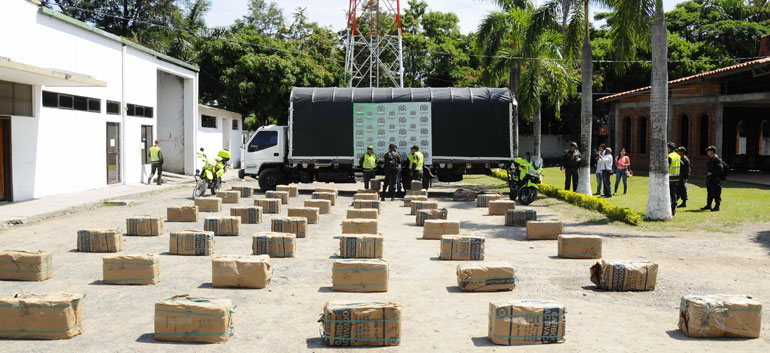Colombia’s top drug traffickers in 2011 offered to turn themselves in and shut down 90% of the country’s drug trade, reported newspaper El Espectador Sunday. The extensive proposal to end drug trafficking reportedly reached the US and Colombian governments but never materialized.
Capos who offered to surrenderRastrojos
ERPAC
El Loco Barrera organization
|
The 109-page document contains the complete ‘ABC’s’ for a plan to close down the business of 90% of the heads of drug trafficking and give up their men. Among those who participated in the proposal were some of Colombia’s top drug lords, such as Luis Enrique Calle, alias “Comba,” alias “Cuchillo,” Diego Rastrojo, and Loco Barrera.
El Espectador, now in possession of the 2011 document called “Agenda for solving the problem of drug trafficking and the violence it generates,” says that that presidential adviser J.J. Rendon apparently officiated as a general strategist for the proposal, which was facilitated by former ELN guerrillas Francisco Galan and Jorge Castañeda.
Other sources consulted by El Espectador confirmed that Rendon was actively involved in creating the plan.
Furthermore, alias “Comba,” Colombia’s most wanted drug lord before his surrender to U.S. authorities in 2012, maintains that the capos gave Rendon $12 million for submitting the proposal.
Rendon has subsequently told El Espectador that there was no exchange of money, that he “that acted as a simple messenger” and “met with the president [Juan Manuel Santos], gave [him the proposal], and left.” Rendon insists that he only recently learned the details of the proposal, adding
Santos told Daniel Coronell of Semana magazine that “yes, it is true” that he received the proposal, confirming that his adviser gave him the letter and video.
However, the proposal was never adopted, and all of the aforementioned cartel leaders later ended up captured, extradited, or negotiating their surrender to the United States.
MORE: Colombia’s most wanted drug lord ‘Comba’ surrenders to US authorities
‘Comprehensive and specific’ proposal to dismantle drug trade
According to El Espectador, the proposal is comprehensive and specific, outlining five premises and four phases of the dismantling operation, with a time line for each phase .
In the proposal, the capos agreed to dismantle drug trafficking and its structures, and to give the state all information on crops, laboratories, informants, and links to the state.
It promised that the “bacrim guerrillas, as well as urban criminal bands and combos” would stop generating violence, and that the drug lords would deliver thousands of acres of land to the government in order to finance productive projects in the areas of dismantling the illegal drug trade.
The document also contained an analysis of how the drug cartels operated between Colombia’s northern gulf of Uraba and Ecuador, the areas of greatest risk, lists of illicit crops, and concrete ideas to suspend business in the Pacific — which according to [the capos’] would reduce drug exports by 60 % in that area.
It also extended a commitment to dismantle operations with FARC guerrillas, offering the location of their crops, and information on exit routes of speedboats, submarines, and ships containing coke.
The proposal to stop traffic in the corridor between Uraba and the northern state of La Guajira alone, where criminal groups the Urabeños, Los Rastrajos, and Paisas operate, was to going to achieve a 50% reduction of drug circulation, and promised delivery of confidential data about patrons of the trade and their links to security forces.
Cartel demobilization
The document also contains estimates of demobilization by each cartel leader. The Comba brothers and Diego Rastrajo promised to take 3,000 of their men out of the business, alias “Sebastian” of Oficina de Envigado cartel promised 2,000 men, the Usuga brothers, now leaders of Los Urabeños, intended to hand over 1,000 of its members, and alias “Valenciano” said he was able to demobilize the same number of men. Additionally, Daniel Loco Barrera and Hector Buitrago, alias “Martin Llanos,” each promised 1,200 of their members.
Although J.J. Rendon told El Espectador that none of these negotiations with the Santos administration were secret, the country is only just now learning of the rejected 2011 proposal to the Santos administration.
Instead, President Santos, who is vying for re-election in Colombia’s upcoming presidential elections, pursued a peace process with the FARC guerrillas.
Three years later
On Saturday May 3, three years after Colombia’s capos proposed to dismantle the drug trade, the 24th round of peace talks between the government and the FARC rebel group continued, addressing the issue of drug trafficking.
According to international newswire Reuters, the Santos administration and FARC have been working on a three point agenda, including a plan to eradicate illicit drug cultivation through crop substitution, a deal on prevention of drug use, and a “solution to the production and sale of narcotics.”
Caracol Radio reported Sunday that these negotiations failed to result in an agreement, and discussion of the illegal drug trade will have to re-open in Havana on May 12.
President Santos’ political career and campaign for re-election have hinged on ending Colombia’s 50 years of armed conflict through the Havana peace process. Recent polls indicate that Santos is likely to win re-election, though a second round of votes is predicted.
MORE: Gallup poll confirms second round of Colombia’s elections likely
Sources
- La oferta secreta de los narcos para entregarse (El Espectador)
- La comba al palo (Semana magazine)
- Colombia rebels say mood in peace talks “couldn’t be better” (Reuters)
- Gobierno y Farc cierran ciclo sin acuerdo sobre tema de narcotráfico (Caracol Radio)


